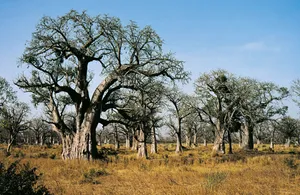
Why the Baobab Tree in News?
- The baobab tree, with its iconic silhouette of a swollen trunk and spindly branches, has captivated imaginations for centuries.
- Endemic not just to Madagascar, but also gracing the landscapes of Africa and Australia, these majestic giants hold a special place in local cultures and ecosystems.
- A recent study published in Nature sheds light on the fascinating origin story of these “mothers of the forest” and the pressing threats they face.
Towering Titans with Ancient Roots
- the Baobabs tree are revered for their grand stature, reaching heights of up to 50 meters and boasting lifespans exceeding 2,000 years.
- India even boasts a few of these ancient wonders, with a specimen near the Golconda Fort in Andhra Pradesh estimated to be over 400 years old.
- Their enormous trunks with vast circumferences stand in stark contrast to their spindly branches, earning them the nickname “upside-down trees.” Legends abound to explain this unique appearance, with one Arab folktale claiming the devil himself uprooted the tree and shoved its branches into the ground.
Beyond Beauty: A Keystone Species
- Beyond their captivating looks, baobabs play a crucial role in the ecosystems they inhabit.
- They are classified as keystone species, meaning their presence is vital for the overall health of the environment.
- Baobab fruits and seeds provide sustenance for animals like lemurs, while their flowers attract sunbirds and hawk moths for pollination.
- The bark fiber finds use in clothing production, and the seed oil is valued for cooking. Their absence would create a domino effect, destabilizing entire ecosystems.
The Study Unveils a 21-Million-Year-Old Mystery
- The recent study titled “The rise of baobab trees in Madagascar” delves into the genetic makeup of these fascinating trees.
- It highlights the precarious situation of three Madagascar baobab species classified as threatened on the IUCN Red List of Threatened Species.
- The remaining three species fall under the Least Concern category, but even their populations are showing signs of decline.
- Habitat loss due to residential and commercial development, along with livestock farming, is a major culprit.
- The study emphasizes the urgent need for stricter conservation measures to safeguard these irreplaceable trees. By analyzing the baobab genome, researchers discovered a strong genetic link between the Malagasy baobabs.
- This suggests a common ancestor that originated in Madagascar a staggering 21 million years ago.
- The seeds of this ancestral baobab were then likely carried by ocean currents to Africa and Australia, where they evolved into distinct species over time.
A Race Against Time: Climate Change and Inbreeding Threats
- The study paints a concerning picture for the future of certain baobab species.
- Climate change is projected to pose a severe threat to Adansonia suarezensi, a Madagascar species, potentially leading to its extinction by 2080.
- Additionally, the analysis revealed high levels of recent inbreeding in both A. suarezensi and A. grandidieri.
- This, coupled with their low genetic diversity, makes them more susceptible to ecological disruptions and habitat fragmentation.
Conclusion
- The baobab tree stands as a testament to nature’s resilience and the interconnectedness of life.
- Understanding their origins and the threats they face is crucial for ensuring their survival. The recent study is a wake-up call, urging for stricter conservation efforts.
- By implementing sustainable practices, raising awareness, and protecting these ecological giants, we can ensure that future generations continue to marvel at the majesty of the baobab.
People also ask
Q1: What are the baobab trees?
Ans: the Baobab trees are known for their distinctive silhouette – a swollen trunk with spindly branches. They can reach up to 50 meters tall and live for over 2,000 years! These giants are found in Madagascar, Africa, and Australia.
Q2: Why are they called “mothers of the forest”?
Ans: The Baobab trees play a vital role in their ecosystems. They provide food and shelter for animals, and their large trunks can store water during dry seasons. Local communities also utilize various parts of the baobab for food, medicine, and clothing.
Q3: Where did the baobab trees originate?
Ans: A recent study suggests baobabs originated in Madagascar roughly 21 million years ago. Their seeds likely traveled by ocean currents to Africa and Australia, where they evolved into distinct species.
Q4: Are the baobab trees endangered?
Ans: Yes, some baobab species are threatened. Habitat loss due to human activities and climate change pose significant dangers. Three Madagascan baobab species are classified as threatened on the IUCN Red List.